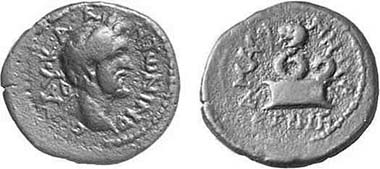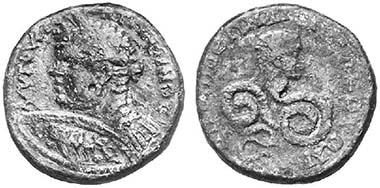You are one of those people who believe than there are more things in heaven and earth than are dreamt of in your philosophy? Well, you are in accordance with a deep-seated tradition and can appeal to the fact that already in antiquity there were people who thought the same as you.
Like, for example, in Abonuteichos, a tiny provincial city at the fringes of the Roman world in Paphlagonia. There, something wonderful had happened: a stately itinerant preacher appeared on the scene and told the city’s inhabitants that Asclepius had decided to settle down, in a new guise, in Abonuteichos, of all. And indeed, some days later, the prophet – naked, in deep trance and accompanied by crowds of curious people – walked to the foundations of the temple which those who were thrilled by the news of Asclepius arriving in the very near future had already begun to build, just in case. There, he found an egg with a snake hatching, newborn Asclepius.
Amaseia (Pontos), Antoninus Pius, AE, 158. Rev. Snake with human head (Glycon) on base l. RG 16var. From auction Gorny & Mosch, Munich 118 (2002), no. 1708.
Some days later, the believers witnessed an impressive spectacle. In a cave, Alexander sat enthroned, wearing lavish clothes. His hair floated beautifully, his garment was loose and embroidered with magic signs. He had the snake wrapped around him that had grown enormously in that short period of time. Not only the unusual quick growth but the appearance of the animal as well betrayed its divine origin. The snake had a head like a human with long hair. Its tongue moved without interruption. The biggest miracle of all: it talked and stated its name and descent: “I am Glycon, descendant of Zeus in the third generation (Zeus was father of Apollo, Apollo father of Asclepius.), light and illumination for mankind.”
The oracle fee was inexpensive. One drachm and two oboloi – even the poor could afford that, and the oracle business flourished. From far and wide came those looking for answers, not only peasants in a long time, but wealthy merchants from the big cities, even a senator from Rome, who was so enthralled by Glycon that he married his daughter off to its prophet, Alexander, at once.
The inhabitants of the city felt happy. Their revenues had multiplied thanks to their god. Hence, they changed the name of their city Abonuteichos, after the bringer of their prosperity, Glycon or Ion, as he called himself, into Ionopolis. Of course, they put the image of their new deity on their coins which is why we today can still marvel at its beauty.
Oh, I see, you are not one of those people who believe in miracles? Well, then you surely like the continuation of the story. In the course of his voyages, the writer Lucian had come to Abonuteichos and wrathfully revealed the true backgrounds of this new oracle. The self-appointed prophet was a tatterdemalion sideshow actor who had acquired one of these tame pet snakes as prop during a trip throughout Macedon. It had given him the idea to exploit the gullibility of these people to ensure him a safe maintenance in his old age – presumably he had become tired of the constant wandering about. And so he moved to his native town, Abonuteichos, located in the middle of nowhere, where he fueled the atmosphere of expectancy with his mysterious prophecies.
The birth of his god was impressively staged: at the near-by Asclepius temple, currently under construction, Alexander hid a goose egg which he had prepared before in a special way. In the egg, that had been carefully sewed in two halves, he put a small snake and closed the visible gap with wax again so that the egg appeared untouched. Great events often come from little causes.
The highly famous god Glycon, we see on this coin, was a virtuous pet snake that had got a new head, home-made from scrap of cloth. Thus, the oracle was necessarily dark to prevent any of the “clients” to find out the secret. The prophet himself made the tongue in the false mouth dart, with the aid of a horse hair. And the voice – well, that was achieved by a tube of goose throats leading to a curtain with a servant behind it who was clever enough to give a fitting, facile answer to any question posed.
If one is inclined to believe Lucian, the prophet Alexander suffered a fate befitting villains: a cancerous illness made his leg rot off right up to his hip, to the result that worms were emerging from it, eventually. His successors couldn’t reach an agreement and so the oracle became less and less important.
Nicomedeia (Bithynia), Caracalla, 197-217. AE. Rev. Snake with human head Glycon in an upright position, in several windings, to the right. RG II, p. 545, – (cf. 225). From auction Numismatik Lanz, Munich 114 (2003), no. 507.
Lucian, however, massaged the story quite a bit to present a moral ending. Actually, the oracle continued to be in business, there are coins preserved from the later times to Trebonianus Gallus (251-253) that depict Glycon, the snake. The cult spread out, particularly in the Danube area, where we find inscriptions and coins devoted to the new god and his prophet.
If there is one thing I wanted to proof with this story then it is the fact that we and the people in antiquity are very much alike, in regard to their fear and worries, their flaws and strong points, their tricks and deceit.







